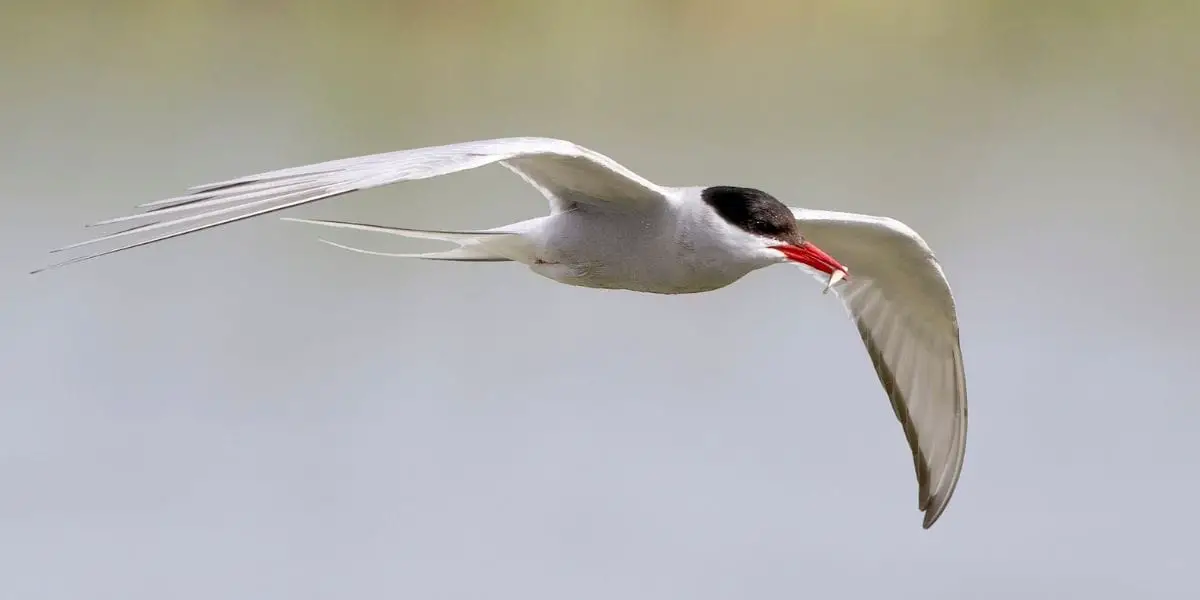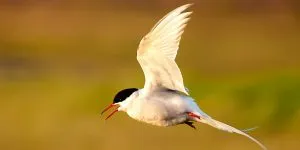It’s over 100 years since Wells W. Cooke (known as the father of bird migration studies) first coined the arctic tern the ‘world’s migration champion’. But with everything we know today, would he still say the same? Why do arctic terns migrate?
Arctic terns migrate from the Arctic to Antarctica every single year, giving them the farthest known migration of any animal on the planet at around 50,000km (31,000 miles) each year. They migrate to the hemisphere that is tilted towards the sun which allows them to enjoy the summer season year-round.
Keep reading to find out about the two different flight paths taken by arctic terns and why the return journey to the arctic is more direct. Alternatively, our facts about arctic terns is a great resource for learning more facts about these migration champions.
Where Do Arctic Terns Migrate?
Once a year, every year, the arctic tern flies from the northern polar region all the way to the southern polar regions of the Earth and back. This amounts to between 45,000–60,000 km (28,000-37,000 miles) each year1 (source: T. Alterstam, et al., Ecology and Evolution, Vol. 9, Issue 17, pp. 9511-9531, 2019).
The timing of arctic tern migration is influenced by temperature changes that come with the changing seasons.
Arctic terns mostly breed in the Arctic between May – July which is summer there. Once fledglings are able to fly and temperatures begin to decrease, the species start their migration towards the southern hemisphere between late July-October.
The species fly over the Atlantic Ocean along the coast of Europe as a congregation then diverge as they approach the equator. Half of the congregation (known as ‘eastern terns’) fly along the coast of Africa, whilst the other half (known as ‘western terns’) fly along the coast of South America.
Despite diverging, the two groups are able to coordinate landing on the Antarctic coast in time for summer which is between November-February here2 (source: C. Egevang, et al., Proceedings of the National Academy of Sciences, Vol. 107, Issue 5, pp. 2078-2081, 2010).
In Antarctica, the species undergo molting, and when temperatures begin to decrease, they will begin migration back north again between February – April.
The route back north is shorter and more direct, this is because they can complete the journey faster and with fewer stop-overs as they are traveling with the wind3 (source: T. Hromádková, et al., Marine Ecology Progress Series, Vol. 638, pp. 1-12, 2020). They soon arrive back in the Arctic region for breeding season again.
The timing of their migration grants them the most amount of daylight hours of any bird.

Why Do Arctic Terns Migrate?
Arctic terns need to have a couple of good reasons to justify rounding up their entire population every year and crossing the globe. The main reasons why arctic terns migrate are:
- Food Resources: They migrate to parts of the globe where there are vastly rich seasonal food resources to be used up. Whilst in Antarctica, the diet of an arctic tern is mostly fish where is extremely abundant.
- The Sun: The species migrate towards the hemisphere of the globe that is tilted towards the sun. If the arctic terns spend winter in a harsh climate, there will be high mortality rates. Therefore, they migrate to enjoy the summer season all year round.
- Suitable Breeding Grounds: They need isolated and food-rich breeding grounds where they can lay, incubate, and hatch eggs with minimal disturbance.
- Molting: They need to molt their feathers every year so that new strong feathers can emerge. This process uses up the birds’ energy, ability to maintain heat and flight capability. They sit on the ice caps of Antarctica where the climate is temperate and predation is at a minimum4 (source: National Wildlife Federation).
How Do Arctic Terns Migrate?
The arctic terns’ wings have ‘high aspect ratio’. This means they are long and narrow. Their shape reduces how much energy the birds spend when flying, whilst increasing how long they can remain in-flight5 (source: National Geographic).
The arctic tern can fly up to 6,000 miles without stopping6 (source: C.P. Redfern and R.M. Bevan, Ibis, Vol. 162, Issue 2, pp.373-380, 2020).
The arctic tern also prefers gliding to flapping their wings. They use low-pressure wind systems to carry them across vast distances. Incredibly, arctic terns can even sleep while gliding!
Gliding is made easier by the species’ pneumatic bones (hollow bones). This means that the overall bodyweight of an arctic tern is around 90-120g (3.2-4.2oz)7 (source: C. Egevang, et al., Proceedings of the National Academy of Sciences, Vol. 107, Issue 5, pp. 2078-2081, 2010), making it one of the lightest terns and far lighter than other similar sized birds such as puffins.
Vital to arctic terns’ success is their use of fat as their main fuel source. Fat is a very energy-dense substrate that can be metabolized slowly over its journey. Thus, maximizing time spent flying8 (source: M. Klaassen, et al., The Condor, Vol 102, Issue 2, pp 444–451, 2000).
Related Questions
Do Arctic Tern Hibernate?
No, arctic terns do not hibernate, instead, they undergo the longest migration known for any species of bird, traveling around 50,000km across the globe from the arctic to the antarctic.
Where Do Arctic Terns Live?
Arctic terns have a wide geographical distribution due to their migratory behavior. During breeding season, arctic terns live in northern parts of Europe, Russia, Canada, and Alaska.
They tend to live in habitats with varying degrees of vegetation and a rich supply of food in the waters. Thus, they are often seen along coastal regions9 (source: Cornell Lab of Ornithology).
Do Arctic Terns Migrate to India?
No, artic terns do not migrate to India. However, they may have been spotted in India on their route to Antarctica. The arctic terns are prone to ‘detours’ for food, sometimes thousands of miles off course. They can land on the coast of India to make use of the supply of fish in the coastal waters.
How Far Do Arctic Terns Fly Every Year?
In total, the arctic terns’ migration amounts to 44,000 – 59,000 miles each year. As this species can live up to 29 years, they are very capable of covering the distance between the earth and moon 3 times in their lifetime10 (source: C. Egevang, et al., Proceedings of the National Academy of Sciences, Vol. 107, Issue 5, pp. 2078-2081, 2010).
How Do Arctic Terns Adapt to Changing Seasons?
Migration is the arctic terns’ response to the changing seasons. If a region’s temperatures start decreasing due to the changing of the season, they will migrate to a warmer region.





![Read more about the article How Big Is The Arctic Tern [Size + Weight Compared]](https://polarguidebook.com/wp-content/uploads/2022/04/How-big-are-arctic-terns-300x150.jpg)